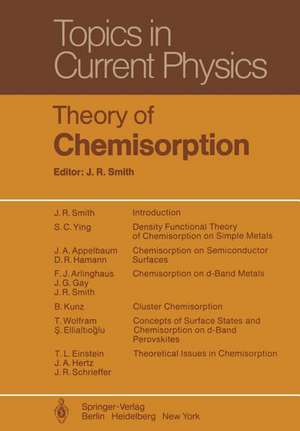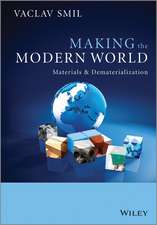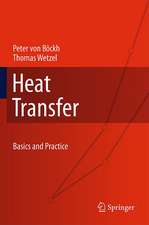Theory of Chemisorption: Topics in Current Physics, cartea 19
Editat de J. R. Smithen Limba Engleză Paperback – 13 dec 2011
Din seria Topics in Current Physics
-
 Preț: 393.13 lei
Preț: 393.13 lei -
 Preț: 401.61 lei
Preț: 401.61 lei - 15%
 Preț: 644.63 lei
Preț: 644.63 lei -
 Preț: 389.31 lei
Preț: 389.31 lei -
 Preț: 391.99 lei
Preț: 391.99 lei - 15%
 Preț: 642.18 lei
Preț: 642.18 lei -
 Preț: 388.90 lei
Preț: 388.90 lei -
 Preț: 382.95 lei
Preț: 382.95 lei -
 Preț: 398.53 lei
Preț: 398.53 lei -
 Preț: 402.98 lei
Preț: 402.98 lei -
 Preț: 388.72 lei
Preț: 388.72 lei -
 Preț: 393.13 lei
Preț: 393.13 lei -
 Preț: 397.38 lei
Preț: 397.38 lei - 15%
 Preț: 642.83 lei
Preț: 642.83 lei -
 Preț: 384.86 lei
Preț: 384.86 lei -
 Preț: 383.33 lei
Preț: 383.33 lei -
 Preț: 385.25 lei
Preț: 385.25 lei -
 Preț: 382.36 lei
Preț: 382.36 lei -
 Preț: 382.36 lei
Preț: 382.36 lei -
 Preț: 382.18 lei
Preț: 382.18 lei -
 Preț: 384.86 lei
Preț: 384.86 lei -
 Preț: 397.59 lei
Preț: 397.59 lei - 15%
 Preț: 639.08 lei
Preț: 639.08 lei -
 Preț: 396.62 lei
Preț: 396.62 lei -
 Preț: 391.40 lei
Preț: 391.40 lei -
 Preț: 382.75 lei
Preț: 382.75 lei -
 Preț: 392.75 lei
Preț: 392.75 lei -
 Preț: 392.60 lei
Preț: 392.60 lei - 15%
 Preț: 643.16 lei
Preț: 643.16 lei -
 Preț: 392.97 lei
Preț: 392.97 lei -
 Preț: 407.01 lei
Preț: 407.01 lei - 15%
 Preț: 638.43 lei
Preț: 638.43 lei -
 Preț: 394.87 lei
Preț: 394.87 lei -
 Preț: 395.09 lei
Preț: 395.09 lei - 15%
 Preț: 641.38 lei
Preț: 641.38 lei -
 Preț: 402.38 lei
Preț: 402.38 lei -
 Preț: 390.63 lei
Preț: 390.63 lei -
 Preț: 387.38 lei
Preț: 387.38 lei -
 Preț: 398.35 lei
Preț: 398.35 lei -
 Preț: 393.35 lei
Preț: 393.35 lei -
 Preț: 384.09 lei
Preț: 384.09 lei - 15%
 Preț: 641.03 lei
Preț: 641.03 lei -
 Preț: 397.01 lei
Preț: 397.01 lei -
 Preț: 395.47 lei
Preț: 395.47 lei - 15%
 Preț: 646.94 lei
Preț: 646.94 lei -
 Preț: 399.67 lei
Preț: 399.67 lei - 15%
 Preț: 642.83 lei
Preț: 642.83 lei - 15%
 Preț: 638.24 lei
Preț: 638.24 lei
Preț: 387.96 lei
Nou
Puncte Express: 582
Preț estimativ în valută:
74.24€ • 79.38$ • 61.90£
74.24€ • 79.38$ • 61.90£
Carte tipărită la comandă
Livrare economică 18 aprilie-02 mai
Preluare comenzi: 021 569.72.76
Specificații
ISBN-13: 9783642814334
ISBN-10: 3642814336
Pagini: 256
Ilustrații: XII, 242 p.
Dimensiuni: 170 x 244 x 13 mm
Greutate: 0.41 kg
Ediția:Softcover reprint of the original 1st ed. 1980
Editura: Springer Berlin, Heidelberg
Colecția Springer
Seria Topics in Current Physics
Locul publicării:Berlin, Heidelberg, Germany
ISBN-10: 3642814336
Pagini: 256
Ilustrații: XII, 242 p.
Dimensiuni: 170 x 244 x 13 mm
Greutate: 0.41 kg
Ediția:Softcover reprint of the original 1st ed. 1980
Editura: Springer Berlin, Heidelberg
Colecția Springer
Seria Topics in Current Physics
Locul publicării:Berlin, Heidelberg, Germany
Public țintă
ResearchCuprins
1. Introduction..- 2. Density Functional Theory of Chemisorption on Simple Metals.- 2.1 Background Information.- 2.2 Statistical Approach.- 2.3 Approach Based on the Solution of Effective One-Electron Schrödinger Equation.- 2.4 Concluding Remarks.- References.- 3. Chemisorption on Semiconductor Surfaces.- 3.1 Background Information.- 3.2 Bulk Properties.- 3.3 General Surface Properties.- 3.4 Computational Approaches.- 3.5 Clean Semiconductor Surfaces.- 3.6 H Chemisorption on Si Surfaces.- 3.7 Cl Chemisorption on Si (111) and Ge(lll).- 3.8 Al Chemisorption on Si (111).- 3.9 Al Chemisorption on GaAs(llO).- References.- 4. Chemisorption on d-Band Metals.- 4.1 Moments Method.- 4.2 Muffin-Tin Methods.- 4.3 Parametrized LCA0 Methods.- 4.4 Linear Combination of Muffin-Tin Orbitals (LCMT0) Method.- 4.5 Self-Consistent Methods.- 4.6 Fully Self-Consistent Methods.- 4.7 Summary.- References.- 5. Cluster Chemisorption..- 5.1 Ideal Choice of Problem for Cluster Simulation.- 5.2 Methods of Obtaining a Solution.- 5.3 Interaction of Cluster and Environment.- 5.4 Examples of Cluster Calculations.- References.- 6. Concepts of Surface States and Chemisorption on d-Band Perovskites.- 6.1 Introductory Remarks.- 6.2 Cluster Models of Transition Metal Oxides.- 6.3 Bulk and Surface Electronic Properties of the Perovskites.- 6.4 Surface Oxygen Vacancy States (SOVS).- 6.5 Photoemission Experiments on SrTi03.- 6.6 Summary.- References.- 7. Theoretical Issues in Chemisorption.- 7.1 Local Density Approximations and Generalizations.- 7.2 The Anderson Model Picture.- 7.3 Beyond the Hartree-Fock Theory.- 7.4 Adatom-Adatom Interactions.- 7.5 Photoemission.- 7.6 Concluding Remarks.- References.













